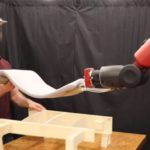 Working effectively with other humans is a central part of working life, and building great teams is fundamental to effective leadership. Working alongside robots is somewhat harder however, especially in physical tasks that require man and machine to coordinate effectively. Whereas humans can sense small changes in motion and coordinate effectively, this is much harder for robots to understand.
Working effectively with other humans is a central part of working life, and building great teams is fundamental to effective leadership. Working alongside robots is somewhat harder however, especially in physical tasks that require man and machine to coordinate effectively. Whereas humans can sense small changes in motion and coordinate effectively, this is much harder for robots to understand.
Until now anyway, as researchers from MIT’s Computer Science and Artificial Intelligence Laboratory (CSAIL) have developed a robot that’s capable of monitoring the muscle movements of human team mates.
The system works by using EMG sensors placed on the arms of the user that monitor muscle activity, with algorithms then used to instantly detect changes in either the position or the movements of the arm and hand. The system was put through its paces in a mock environment similar to that found in airplane manufacturing. The experiments allowed the human/robot teams to place materials within a few inches of the desired height, with the robot responding correctly to around 70% of the gestures made by their human colleague.
“Our approach to lifting objects with a robot aims to be intuitive and similar to how you might lift something with another person – roughly copying each other’s motions while inferring helpful adjustments. The key insight is to use nonverbal cues that encode instructions for how to coordinate, for example to lift a little higher or lower” the researchers explain. “Using muscle signals to communicate almost makes the robot an extension of yourself that you can fluidly control.”
Signal and noise
The system, known as RoboRaise, gets around the problem of poor quality EMG signals by ensuring that the human remains in control of proceedings. An array of non-invasive sensors are placed on the body to detect the neurons that fire when our muscles tense or relax.
These signals are then analyzed by the algorithm to understand how the human arm is moving and therefore how the robot needs to respond.
The system is designed to require minimal calibration before its usable, with users simply required to tense and relax their arm a few times whilst wearing the sensors and lift a weight to various heights to simulate typical movements.
RoboRaise was put through its paces on a series of assembly tasks, including lifting a rubber sheet onto a base structure, and it was able to lift both a number of rigid and flexible items successfully. During testing the rig was installed onto a Baxter robot, but the team believe it could easily be deployed on any robotic platform.
The project is still at an early stage, and the team hope to explore added functionality that will allow RoboRaise to work with different muscle groups, and even appreciate and predict fatigue in their human colleague. It’s certainly an interesting tool, and you can see it in action via the video below.